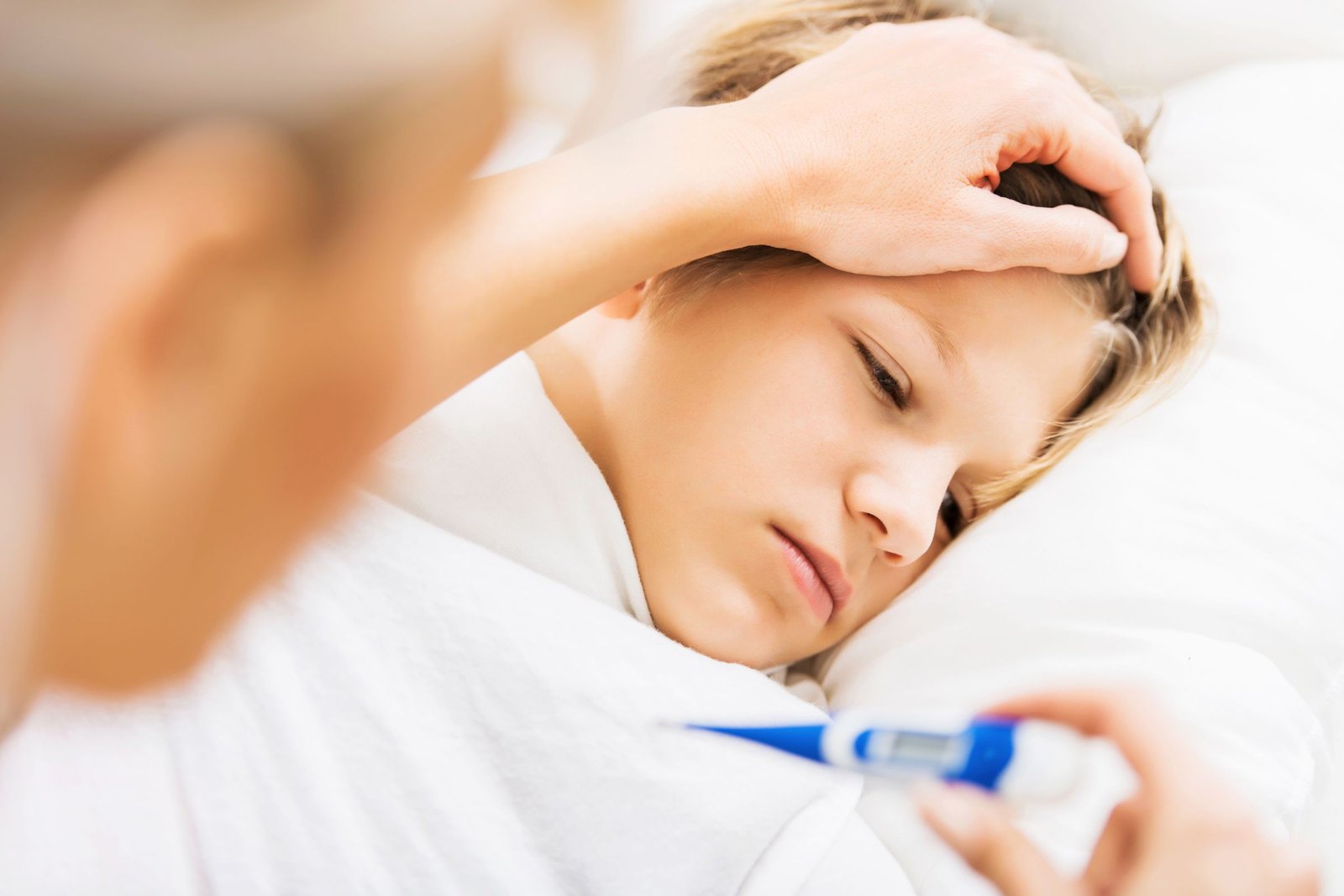When your child develops a fever, it’s only natural to feel concerned. Understanding how to navigate through this common childhood ailment at home is crucial for both parents and caregivers. In this guide, we’ll explore effective ways to provide comfort to your child during a fever, covering topics such as antipyretics, fluid intake, cooling methods, and when to seek professional medical help.
Understanding Fever

A fever, characterized by a body temperature higher than 38°C, is a biological defense mechanism initiated by the immune system to combat infections. When your child’s body temperature rises, it’s a clear indication that their immune system is actively engaged in the battle against a harmful pathogen.
It’s crucial for parents and caregivers to shift their focus from fixating solely on the numerical value of the temperature reading to understanding how the child is feeling. While it’s natural to be concerned about a high temperature, it’s often more important to gauge the child’s overall well-being. Fever itself is rarely the cause of organ damage, especially when associated with common infectious diseases.
During viral infections, moderate elevations in body temperature are typical and can persist for 2-3 days. This is a natural part of the body’s defense mechanism and is not necessarily cause for alarm. Understanding this normal duration can help alleviate unnecessary anxiety and allow caregivers to provide support through the course of the illness.
By recognizing fever as a sign of the immune system actively responding to an infection, parents can approach the situation with a more informed and composed mindset. This perspective allows for a more holistic approach to care, focusing on the child’s comfort and overall well-being rather than being overly concerned about the duration or specific temperature reading.
Antipyretics Usage

When considering the use of antipyretic medications for a child with a fever, it’s essential to approach it judiciously and under specific circumstances.
Threshold for Administration: Antipyretics should be administered only when the fever causes significant discomfort, especially if it surpasses 39.0°C. It’s crucial to recognize that fever itself is a natural response and often not harmful. Therefore, the decision to use antipyretics should be based on the child’s well-being and comfort rather than solely on the numerical temperature reading.
Consultation for Infants: Before giving antipyretics to children under 3 months old, it is imperative to consult with a healthcare professional. Infants in this age group may have different physiological responses, and any medication should be administered under the guidance of a pediatrician.
Common Options: When deemed appropriate, common antipyretic options include ibuprofen or paracetamol. These medications should be given in doses suitable for the child’s age and weight. Caregivers should refer to the recommended dosage guidelines on the medication packaging or, when in doubt, consult a healthcare professional for personalized advice.
Assessing Medication’s Effect: After administering an antipyretic, it’s essential to allow sufficient time for the medication to take effect. Waiting at least 30-40 minutes before reassessing the child’s temperature ensures a more accurate evaluation of the medication’s impact. It’s important to note that the goal is not necessarily to bring the temperature back to normal but to provide relief from discomfort.
Positive Outcome: Understanding that a one-degree drop in temperature is considered a positive response can help manage expectations. The focus should be on the child’s comfort rather than achieving a specific temperature target. This perspective can ease parental concerns and contribute to a more measured approach to fever management.
By adhering to these guidelines, caregivers can make informed decisions regarding the use of antipyretics, ensuring the well-being and comfort of the child while maintaining a balanced perspective on fever management.
Hydration Matters

Ensuring adequate hydration is a fundamental aspect of caring for a child with a fever. Proper fluid intake plays a crucial role in supporting the body’s immune response and preventing dehydration, especially when a fever is present.
Breastfeeding for Infants: For exclusively breastfed infants, increasing the frequency of breastfeeding sessions is highly recommended. Breast milk provides essential nutrients and hydration, contributing to the overall well-being of the child. Offering the breast more often helps meet the increased demand for fluids during a fever.
Fluid Options for Older Children: Children who are not exclusively breastfed should be offered additional fluids, such as cool water or tea. These options can help replenish lost fluids and maintain hydration levels. Opt for caffeine-free and sugar-free beverages to ensure they contribute positively to the child’s health.
Monitoring Urination Frequency: Regular monitoring of the child’s urination frequency is a vital indicator of hydration status. The frequency of urination should align with the child’s healthy patterns. A decrease in urination may signify dehydration, prompting the need for increased fluid intake.
Creative Approaches for Encouraging Fluid Intake: Children may sometimes be resistant to drinking fluids, especially when feeling unwell. To encourage hydration, consider creative approaches such as using a small glass, a straw, or a water bottle with a sports nozzle. Turning fluid intake into a playful and engaging activity can make it more appealing to the child.
Balancing Fluid Intake with Other Care Measures: While focusing on hydration, it’s essential to balance fluid intake with other care measures, such as appropriate clothing and fever management. Combining these strategies ensures a comprehensive approach to keeping the child comfortable and supported during the illness.
Remember, each child is unique, and preferences for fluids may vary. By being attentive to the child’s cues and incorporating creative methods, caregivers can foster a positive attitude toward fluid intake, contributing to the child’s overall recovery during a fever.
Cooling Techniques

When managing a child’s fever, employing effective and safe cooling techniques is paramount to enhance comfort without causing undue discomfort. Here’s a comprehensive guide to cooling strategies:
Appropriate Clothing: Dress your child in lightweight, breathable clothing to facilitate heat dissipation. Remove unnecessary layers to prevent overheating. Opt for materials like cotton that allow air circulation and aid in regulating body temperature.
Wet Compresses: Apply wet compresses to the child’s forehead to help alleviate discomfort. Ensure that the compress is at body temperature, neither too hot nor too cold. This gentle method can offer relief by promoting a cooling effect without causing shock to the system.
Avoid Cold Dressings: While wet compresses are beneficial, it’s crucial to avoid cold dressings. The sudden contrast between the child’s body temperature and excessively cold dressings may lead to discomfort and shivering. Opting for tepid compresses is more comfortable and effective.
No Cold Water Immersion: Contrary to popular belief, immersing a child in cold water is not a recommended method for fever reduction. The abrupt change in body temperature can be distressing for the child and may lead to adverse reactions. Stick to milder, safer cooling methods.
Avoid Alcohol Rubs: Refrain from rubbing the child’s skin with alcohol or alcohol-based solutions. While alcohol evaporates quickly, even a small amount absorbed through the skin can have adverse effects on the nervous system. Opt for safer alternatives like tepid water for compresses.
Maintain a Comfortable Room Temperature: Ensure that the room where the child rests is at a comfortable temperature. Avoid extremes, such as overly warm or cold environments. Adequate ventilation contributes to a soothing atmosphere for the child.
Monitor the Child’s Response: Regularly assess how the child responds to cooling measures. If they appear more comfortable and their fever decreases, the chosen techniques are likely effective. However, if the child becomes agitated or uncomfortable, it may be necessary to adjust the cooling methods.
Consult with a Healthcare Professional: If unsure about the appropriateness of cooling techniques or if the child’s fever persists, consult with a healthcare professional. They can provide personalized advice based on the child’s specific condition.
By implementing these cooling techniques thoughtfully and avoiding potentially harmful practices, caregivers can contribute to the child’s comfort during a fever, promoting a smoother recovery process.
When to Seek Professional Help

While many fevers in children can be effectively managed at home, it is crucial for caregivers to be vigilant for warning signs that may indicate a need for immediate medical attention. Recognizing these signs early on ensures that the child receives timely and appropriate care. Here are specific indicators that warrant seeking professional help:
Changes in Activity Levels: If you observe significant changes in your child’s activity, such as increased sleepiness, prolonged periods of difficulty waking up, or unusual lethargy, it’s essential to consult with a healthcare professional promptly.
Feeding Issues in Infants: For infants, any noticeable changes in feeding patterns, such as reluctance to suckle or a decrease in appetite, may be a cause for concern. If your baby is eating less than usual, seek medical advice.
Jaundice: The sudden appearance or worsening of jaundice, indicated by yellowing of the skin and eyes, is a potential sign of underlying health issues. This requires immediate medical attention.
Abnormal Breathing Patterns: Unusual breathing patterns, including rapid breathing, difficulty breathing, or persistent wheezing, should be addressed promptly. These symptoms may indicate respiratory distress.
Persistent Rashes: If rashes persist and do not fade when pressed (petechiae), it may be indicative of a more serious condition. Consult with a healthcare professional for a thorough assessment.
Reduced Urination: A noticeable decrease in the frequency of urination or signs of dehydration, such as crying without tears, may suggest a need for medical intervention. Adequate fluid intake is crucial during a fever, and reduced urination may signal dehydration.
Severe Headaches: If your child complains of severe headaches that are persistent and not alleviated with usual care measures, seek medical attention. Severe headaches can be indicative of various underlying issues.
Stiff Neck: A stiff neck, especially when accompanied by other symptoms such as fever, requires prompt medical evaluation. This could be a sign of meningitis, a serious infection affecting the membranes surrounding the brain and spinal cord.
Cramps: Unexplained and severe abdominal cramps or pain warrant medical attention. These symptoms may indicate an underlying gastrointestinal issue or other health concerns.
Limb Swelling or Pain: Swelling, pain, or reduced movement in the arms or legs should not be ignored. These symptoms may be indicative of an injury, infection, or other medical conditions that require professional assessment.
Special Consideration for Infants: If your child is under 3 months old, any signs of illness should be promptly discussed with a family doctor. Infants in this age group are more vulnerable to infections and may require immediate attention even for seemingly mild symptoms.
In summary, while home care is suitable for most fevers, paying attention to these warning signs ensures that any potential complications are identified early, leading to appropriate medical intervention and ensuring the best possible outcome for the child. If in doubt, always consult with a healthcare professional for personalized guidance.
Conclusion
Navigating a child’s fever at home involves a combination of comfort measures and vigilance for potential complications. By understanding when to intervene with antipyretics, promoting proper hydration, and utilizing safe cooling techniques, parents and caregivers can provide effective home care during this common childhood illness.
This article is intended for informational purposes only and does not substitute for professional medical advice, diagnosis, or treatment. The information provided here is based on general guidelines and should not be considered a replacement for individualized healthcare.
While the content of this article aims to offer general insights into managing a child’s fever at home, it is crucial to recognize that individual cases may require different approaches. The decision-making process regarding a child’s health should involve consultation with a healthcare professional who can assess the child’s condition comprehensively.
The authors and publishers of this article are not responsible for any consequences or liabilities arising directly or indirectly from the information provided. If you have any concerns about your child’s health or well-being, seek prompt medical attention from a qualified healthcare provider.








